Social Media Integration within IMC Frameworks: Services Marketers
VerifiedAdded on 2022/09/08
|34
|12284
|22
Literature Review
AI Summary
This paper explores the integration of social media (SM) within Integrated Marketing Communication (IMC) frameworks from the perspective of services marketers. It addresses the increasing significance of SM in marketing communications and its impact on organizations, communities, and individuals. The study identifies a gap in existing IMC frameworks, which were developed before the widespread use of SM and do not adequately reflect the unique characteristics of the services industry, such as intangibility and the entwined customer-employee relationship. The research aims to provide insights into the strategic roles of SM for services organizations and to develop a modified IMC framework that integrates SM with traditional media (TM), offering contemporary guidelines for managers and researchers in the services marketing area. It reviews the characteristics of SM in comparison to TM, including interactivity, individualization, integration of communication and distribution channels, immediacy, and information collection. The paper also discusses the implications of service characteristics for marketing communications planning, emphasizing the need for cues of tangibility and consideration of the employee-customer interaction.
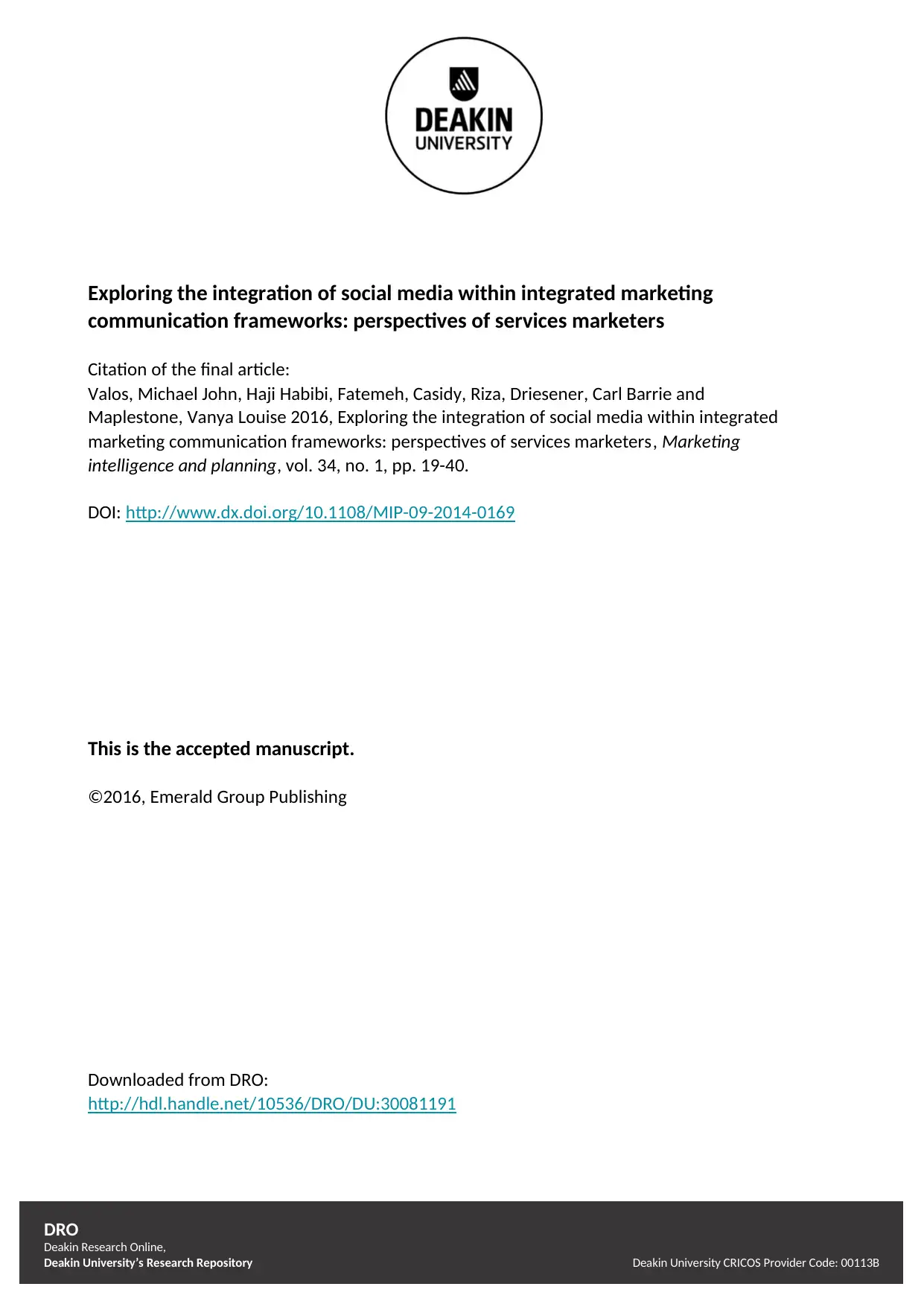
DRO
Deakin Research Online,
Deakin University’s Research Repository Deakin University CRICOS Provider Code: 00113B
Exploring the integration of social media within integrated marketing
communication frameworks: perspectives of services marketers
Citation of the final article:
Valos, Michael John, Haji Habibi, Fatemeh, Casidy, Riza, Driesener, Carl Barrie and
Maplestone, Vanya Louise 2016, Exploring the integration of social media within integrated
marketing communication frameworks: perspectives of services marketers, Marketing
intelligence and planning, vol. 34, no. 1, pp. 19-40.
DOI: http://www.dx.doi.org/10.1108/MIP-09-2014-0169
This is the accepted manuscript.
©2016, Emerald Group Publishing
Downloaded from DRO:
http://hdl.handle.net/10536/DRO/DU:30081191
Deakin Research Online,
Deakin University’s Research Repository Deakin University CRICOS Provider Code: 00113B
Exploring the integration of social media within integrated marketing
communication frameworks: perspectives of services marketers
Citation of the final article:
Valos, Michael John, Haji Habibi, Fatemeh, Casidy, Riza, Driesener, Carl Barrie and
Maplestone, Vanya Louise 2016, Exploring the integration of social media within integrated
marketing communication frameworks: perspectives of services marketers, Marketing
intelligence and planning, vol. 34, no. 1, pp. 19-40.
DOI: http://www.dx.doi.org/10.1108/MIP-09-2014-0169
This is the accepted manuscript.
©2016, Emerald Group Publishing
Downloaded from DRO:
http://hdl.handle.net/10536/DRO/DU:30081191
Paraphrase This Document
Need a fresh take? Get an instant paraphrase of this document with our AI Paraphraser
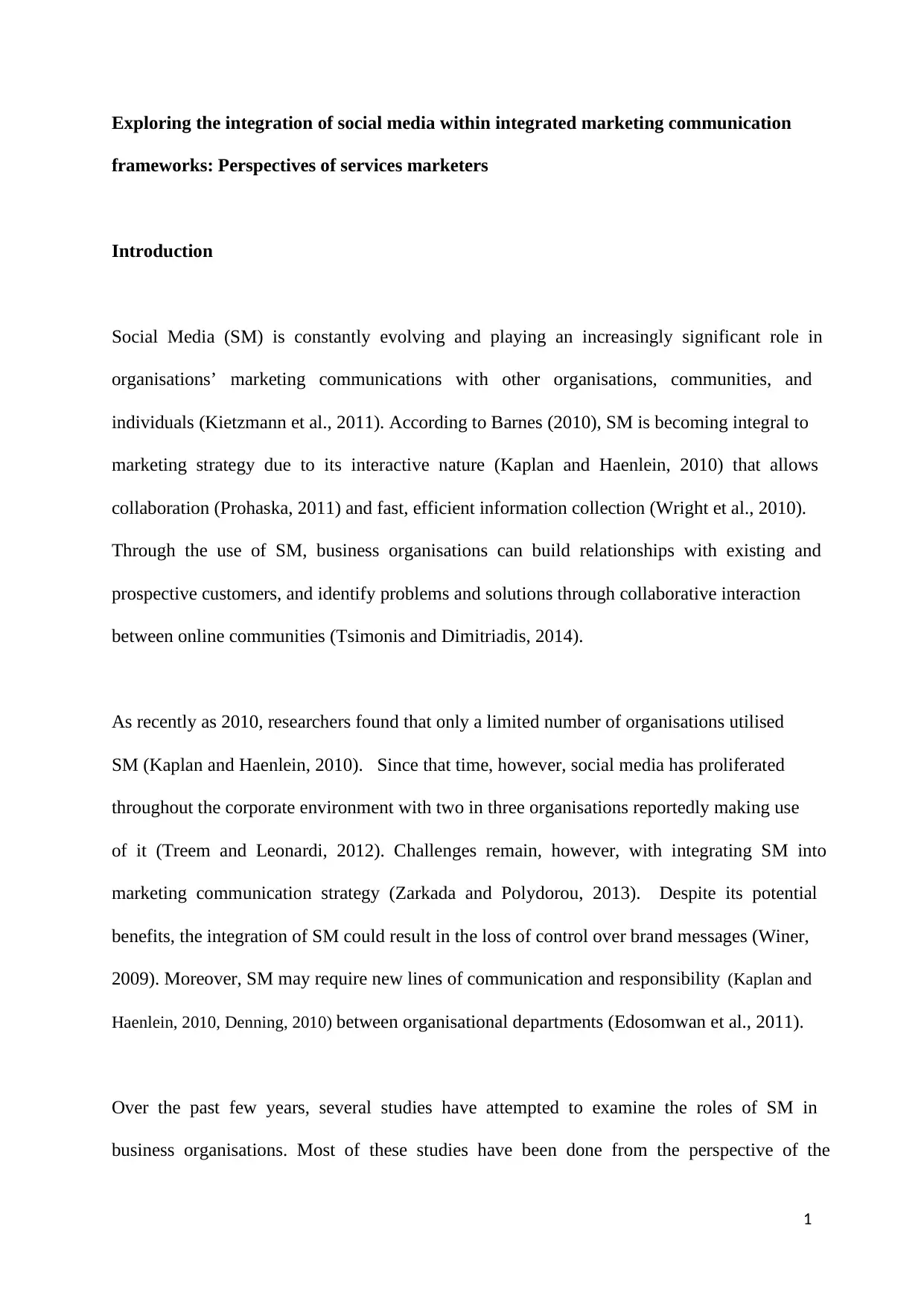
1
Exploring the integration of social media within integrated marketing communication
frameworks: Perspectives of services marketers
Introduction
Social Media (SM) is constantly evolving and playing an increasingly significant role in
organisations’ marketing communications with other organisations, communities, and
individuals (Kietzmann et al., 2011). According to Barnes (2010), SM is becoming integral to
marketing strategy due to its interactive nature (Kaplan and Haenlein, 2010) that allows
collaboration (Prohaska, 2011) and fast, efficient information collection (Wright et al., 2010).
Through the use of SM, business organisations can build relationships with existing and
prospective customers, and identify problems and solutions through collaborative interaction
between online communities (Tsimonis and Dimitriadis, 2014).
As recently as 2010, researchers found that only a limited number of organisations utilised
SM (Kaplan and Haenlein, 2010). Since that time, however, social media has proliferated
throughout the corporate environment with two in three organisations reportedly making use
of it (Treem and Leonardi, 2012). Challenges remain, however, with integrating SM into
marketing communication strategy (Zarkada and Polydorou, 2013). Despite its potential
benefits, the integration of SM could result in the loss of control over brand messages (Winer,
2009). Moreover, SM may require new lines of communication and responsibility (Kaplan and
Haenlein, 2010, Denning, 2010) between organisational departments (Edosomwan et al., 2011).
Over the past few years, several studies have attempted to examine the roles of SM in
business organisations. Most of these studies have been done from the perspective of the
Exploring the integration of social media within integrated marketing communication
frameworks: Perspectives of services marketers
Introduction
Social Media (SM) is constantly evolving and playing an increasingly significant role in
organisations’ marketing communications with other organisations, communities, and
individuals (Kietzmann et al., 2011). According to Barnes (2010), SM is becoming integral to
marketing strategy due to its interactive nature (Kaplan and Haenlein, 2010) that allows
collaboration (Prohaska, 2011) and fast, efficient information collection (Wright et al., 2010).
Through the use of SM, business organisations can build relationships with existing and
prospective customers, and identify problems and solutions through collaborative interaction
between online communities (Tsimonis and Dimitriadis, 2014).
As recently as 2010, researchers found that only a limited number of organisations utilised
SM (Kaplan and Haenlein, 2010). Since that time, however, social media has proliferated
throughout the corporate environment with two in three organisations reportedly making use
of it (Treem and Leonardi, 2012). Challenges remain, however, with integrating SM into
marketing communication strategy (Zarkada and Polydorou, 2013). Despite its potential
benefits, the integration of SM could result in the loss of control over brand messages (Winer,
2009). Moreover, SM may require new lines of communication and responsibility (Kaplan and
Haenlein, 2010, Denning, 2010) between organisational departments (Edosomwan et al., 2011).
Over the past few years, several studies have attempted to examine the roles of SM in
business organisations. Most of these studies have been done from the perspective of the
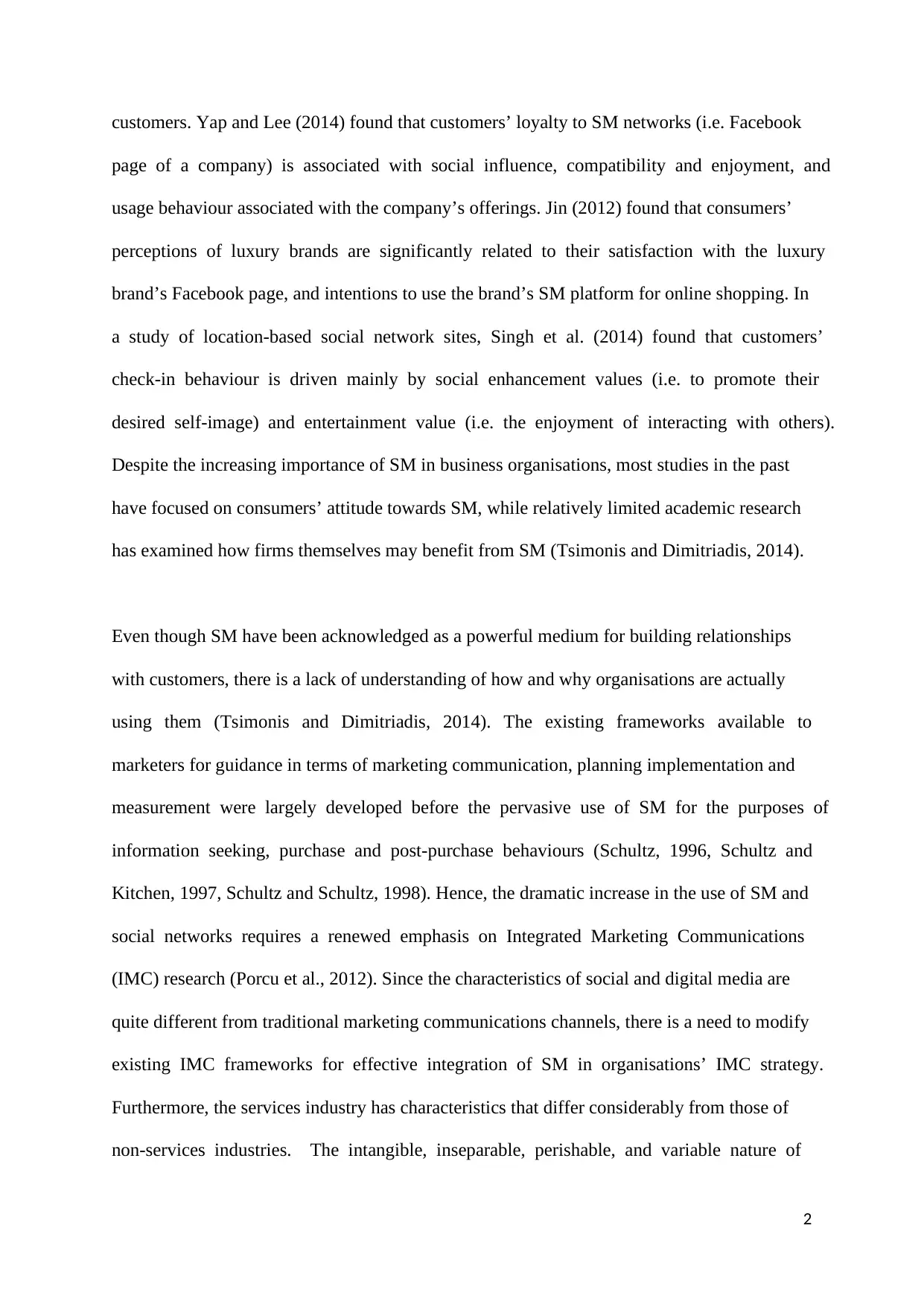
2
customers. Yap and Lee (2014) found that customers’ loyalty to SM networks (i.e. Facebook
page of a company) is associated with social influence, compatibility and enjoyment, and
usage behaviour associated with the company’s offerings. Jin (2012) found that consumers’
perceptions of luxury brands are significantly related to their satisfaction with the luxury
brand’s Facebook page, and intentions to use the brand’s SM platform for online shopping. In
a study of location-based social network sites, Singh et al. (2014) found that customers’
check-in behaviour is driven mainly by social enhancement values (i.e. to promote their
desired self-image) and entertainment value (i.e. the enjoyment of interacting with others).
Despite the increasing importance of SM in business organisations, most studies in the past
have focused on consumers’ attitude towards SM, while relatively limited academic research
has examined how firms themselves may benefit from SM (Tsimonis and Dimitriadis, 2014).
Even though SM have been acknowledged as a powerful medium for building relationships
with customers, there is a lack of understanding of how and why organisations are actually
using them (Tsimonis and Dimitriadis, 2014). The existing frameworks available to
marketers for guidance in terms of marketing communication, planning implementation and
measurement were largely developed before the pervasive use of SM for the purposes of
information seeking, purchase and post-purchase behaviours (Schultz, 1996, Schultz and
Kitchen, 1997, Schultz and Schultz, 1998). Hence, the dramatic increase in the use of SM and
social networks requires a renewed emphasis on Integrated Marketing Communications
(IMC) research (Porcu et al., 2012). Since the characteristics of social and digital media are
quite different from traditional marketing communications channels, there is a need to modify
existing IMC frameworks for effective integration of SM in organisations’ IMC strategy.
Furthermore, the services industry has characteristics that differ considerably from those of
non-services industries. The intangible, inseparable, perishable, and variable nature of
customers. Yap and Lee (2014) found that customers’ loyalty to SM networks (i.e. Facebook
page of a company) is associated with social influence, compatibility and enjoyment, and
usage behaviour associated with the company’s offerings. Jin (2012) found that consumers’
perceptions of luxury brands are significantly related to their satisfaction with the luxury
brand’s Facebook page, and intentions to use the brand’s SM platform for online shopping. In
a study of location-based social network sites, Singh et al. (2014) found that customers’
check-in behaviour is driven mainly by social enhancement values (i.e. to promote their
desired self-image) and entertainment value (i.e. the enjoyment of interacting with others).
Despite the increasing importance of SM in business organisations, most studies in the past
have focused on consumers’ attitude towards SM, while relatively limited academic research
has examined how firms themselves may benefit from SM (Tsimonis and Dimitriadis, 2014).
Even though SM have been acknowledged as a powerful medium for building relationships
with customers, there is a lack of understanding of how and why organisations are actually
using them (Tsimonis and Dimitriadis, 2014). The existing frameworks available to
marketers for guidance in terms of marketing communication, planning implementation and
measurement were largely developed before the pervasive use of SM for the purposes of
information seeking, purchase and post-purchase behaviours (Schultz, 1996, Schultz and
Kitchen, 1997, Schultz and Schultz, 1998). Hence, the dramatic increase in the use of SM and
social networks requires a renewed emphasis on Integrated Marketing Communications
(IMC) research (Porcu et al., 2012). Since the characteristics of social and digital media are
quite different from traditional marketing communications channels, there is a need to modify
existing IMC frameworks for effective integration of SM in organisations’ IMC strategy.
Furthermore, the services industry has characteristics that differ considerably from those of
non-services industries. The intangible, inseparable, perishable, and variable nature of
⊘ This is a preview!⊘
Do you want full access?
Subscribe today to unlock all pages.

Trusted by 1+ million students worldwide
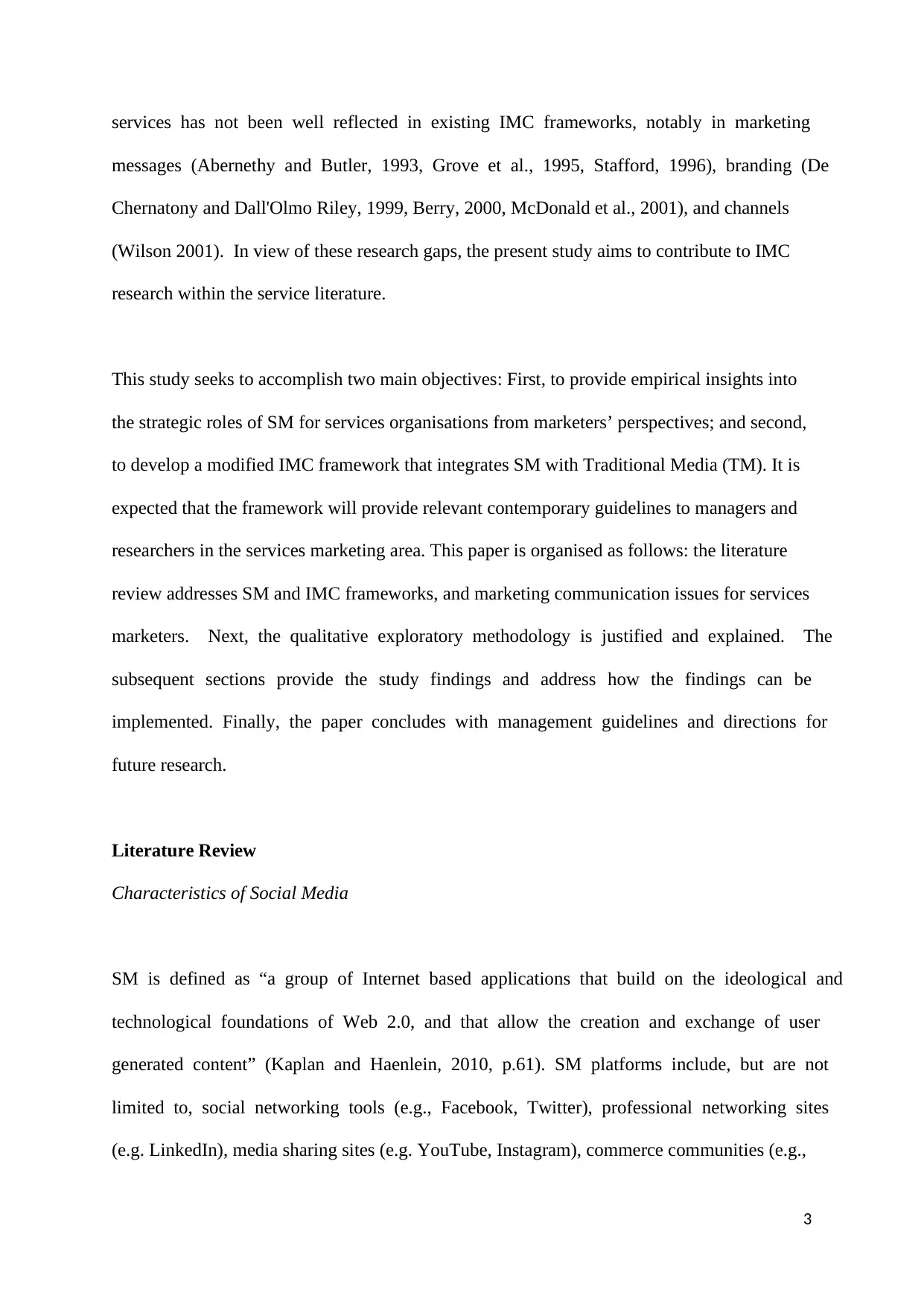
3
services has not been well reflected in existing IMC frameworks, notably in marketing
messages (Abernethy and Butler, 1993, Grove et al., 1995, Stafford, 1996), branding (De
Chernatony and Dall'Olmo Riley, 1999, Berry, 2000, McDonald et al., 2001), and channels
(Wilson 2001). In view of these research gaps, the present study aims to contribute to IMC
research within the service literature.
This study seeks to accomplish two main objectives: First, to provide empirical insights into
the strategic roles of SM for services organisations from marketers’ perspectives; and second,
to develop a modified IMC framework that integrates SM with Traditional Media (TM). It is
expected that the framework will provide relevant contemporary guidelines to managers and
researchers in the services marketing area. This paper is organised as follows: the literature
review addresses SM and IMC frameworks, and marketing communication issues for services
marketers. Next, the qualitative exploratory methodology is justified and explained. The
subsequent sections provide the study findings and address how the findings can be
implemented. Finally, the paper concludes with management guidelines and directions for
future research.
Literature Review
Characteristics of Social Media
SM is defined as “a group of Internet based applications that build on the ideological and
technological foundations of Web 2.0, and that allow the creation and exchange of user
generated content” (Kaplan and Haenlein, 2010, p.61). SM platforms include, but are not
limited to, social networking tools (e.g., Facebook, Twitter), professional networking sites
(e.g. LinkedIn), media sharing sites (e.g. YouTube, Instagram), commerce communities (e.g.,
services has not been well reflected in existing IMC frameworks, notably in marketing
messages (Abernethy and Butler, 1993, Grove et al., 1995, Stafford, 1996), branding (De
Chernatony and Dall'Olmo Riley, 1999, Berry, 2000, McDonald et al., 2001), and channels
(Wilson 2001). In view of these research gaps, the present study aims to contribute to IMC
research within the service literature.
This study seeks to accomplish two main objectives: First, to provide empirical insights into
the strategic roles of SM for services organisations from marketers’ perspectives; and second,
to develop a modified IMC framework that integrates SM with Traditional Media (TM). It is
expected that the framework will provide relevant contemporary guidelines to managers and
researchers in the services marketing area. This paper is organised as follows: the literature
review addresses SM and IMC frameworks, and marketing communication issues for services
marketers. Next, the qualitative exploratory methodology is justified and explained. The
subsequent sections provide the study findings and address how the findings can be
implemented. Finally, the paper concludes with management guidelines and directions for
future research.
Literature Review
Characteristics of Social Media
SM is defined as “a group of Internet based applications that build on the ideological and
technological foundations of Web 2.0, and that allow the creation and exchange of user
generated content” (Kaplan and Haenlein, 2010, p.61). SM platforms include, but are not
limited to, social networking tools (e.g., Facebook, Twitter), professional networking sites
(e.g. LinkedIn), media sharing sites (e.g. YouTube, Instagram), commerce communities (e.g.,
Paraphrase This Document
Need a fresh take? Get an instant paraphrase of this document with our AI Paraphraser
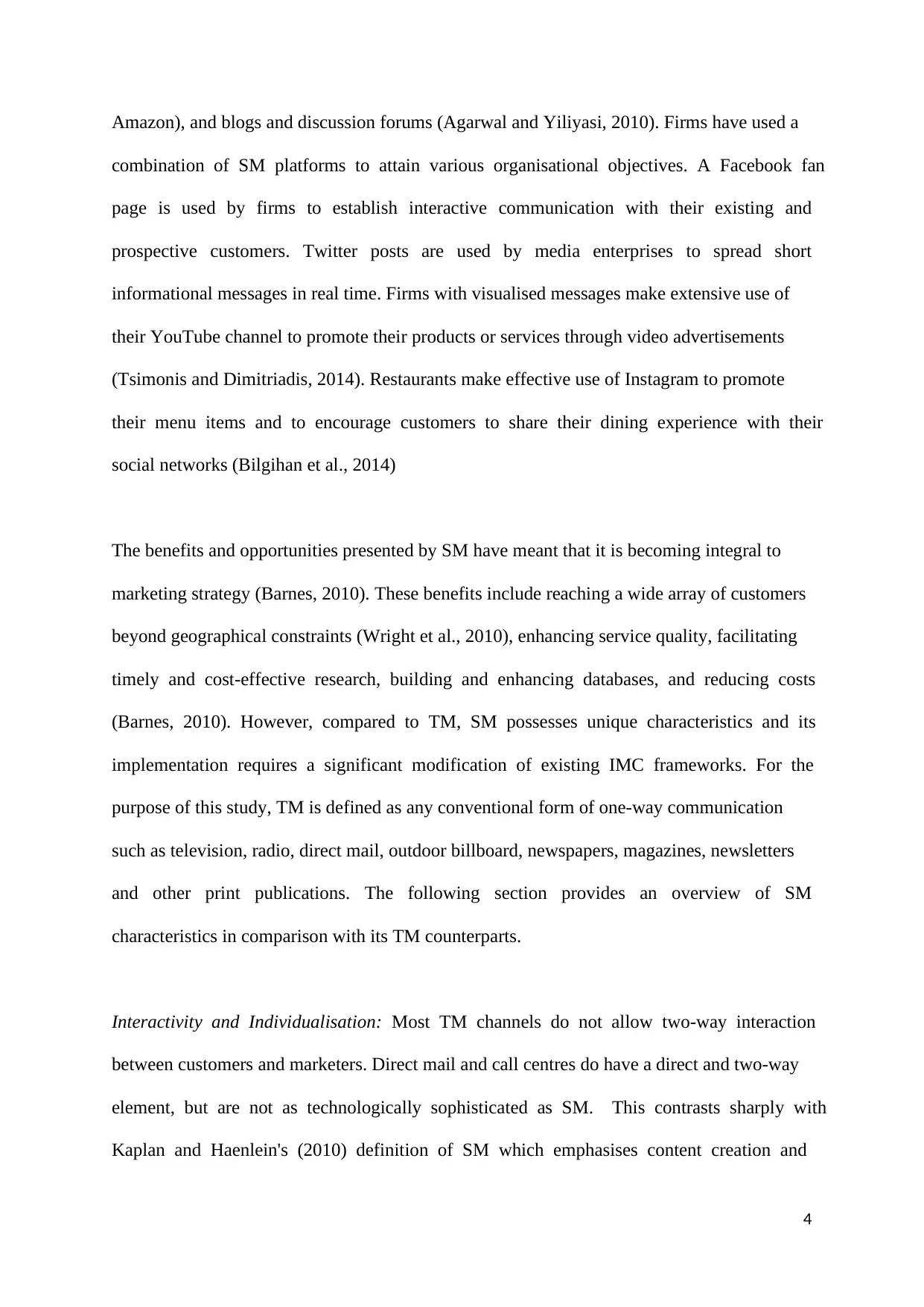
4
Amazon), and blogs and discussion forums (Agarwal and Yiliyasi, 2010). Firms have used a
combination of SM platforms to attain various organisational objectives. A Facebook fan
page is used by firms to establish interactive communication with their existing and
prospective customers. Twitter posts are used by media enterprises to spread short
informational messages in real time. Firms with visualised messages make extensive use of
their YouTube channel to promote their products or services through video advertisements
(Tsimonis and Dimitriadis, 2014). Restaurants make effective use of Instagram to promote
their menu items and to encourage customers to share their dining experience with their
social networks (Bilgihan et al., 2014)
The benefits and opportunities presented by SM have meant that it is becoming integral to
marketing strategy (Barnes, 2010). These benefits include reaching a wide array of customers
beyond geographical constraints (Wright et al., 2010), enhancing service quality, facilitating
timely and cost-effective research, building and enhancing databases, and reducing costs
(Barnes, 2010). However, compared to TM, SM possesses unique characteristics and its
implementation requires a significant modification of existing IMC frameworks. For the
purpose of this study, TM is defined as any conventional form of one-way communication
such as television, radio, direct mail, outdoor billboard, newspapers, magazines, newsletters
and other print publications. The following section provides an overview of SM
characteristics in comparison with its TM counterparts.
Interactivity and Individualisation: Most TM channels do not allow two-way interaction
between customers and marketers. Direct mail and call centres do have a direct and two-way
element, but are not as technologically sophisticated as SM. This contrasts sharply with
Kaplan and Haenlein's (2010) definition of SM which emphasises content creation and
Amazon), and blogs and discussion forums (Agarwal and Yiliyasi, 2010). Firms have used a
combination of SM platforms to attain various organisational objectives. A Facebook fan
page is used by firms to establish interactive communication with their existing and
prospective customers. Twitter posts are used by media enterprises to spread short
informational messages in real time. Firms with visualised messages make extensive use of
their YouTube channel to promote their products or services through video advertisements
(Tsimonis and Dimitriadis, 2014). Restaurants make effective use of Instagram to promote
their menu items and to encourage customers to share their dining experience with their
social networks (Bilgihan et al., 2014)
The benefits and opportunities presented by SM have meant that it is becoming integral to
marketing strategy (Barnes, 2010). These benefits include reaching a wide array of customers
beyond geographical constraints (Wright et al., 2010), enhancing service quality, facilitating
timely and cost-effective research, building and enhancing databases, and reducing costs
(Barnes, 2010). However, compared to TM, SM possesses unique characteristics and its
implementation requires a significant modification of existing IMC frameworks. For the
purpose of this study, TM is defined as any conventional form of one-way communication
such as television, radio, direct mail, outdoor billboard, newspapers, magazines, newsletters
and other print publications. The following section provides an overview of SM
characteristics in comparison with its TM counterparts.
Interactivity and Individualisation: Most TM channels do not allow two-way interaction
between customers and marketers. Direct mail and call centres do have a direct and two-way
element, but are not as technologically sophisticated as SM. This contrasts sharply with
Kaplan and Haenlein's (2010) definition of SM which emphasises content creation and
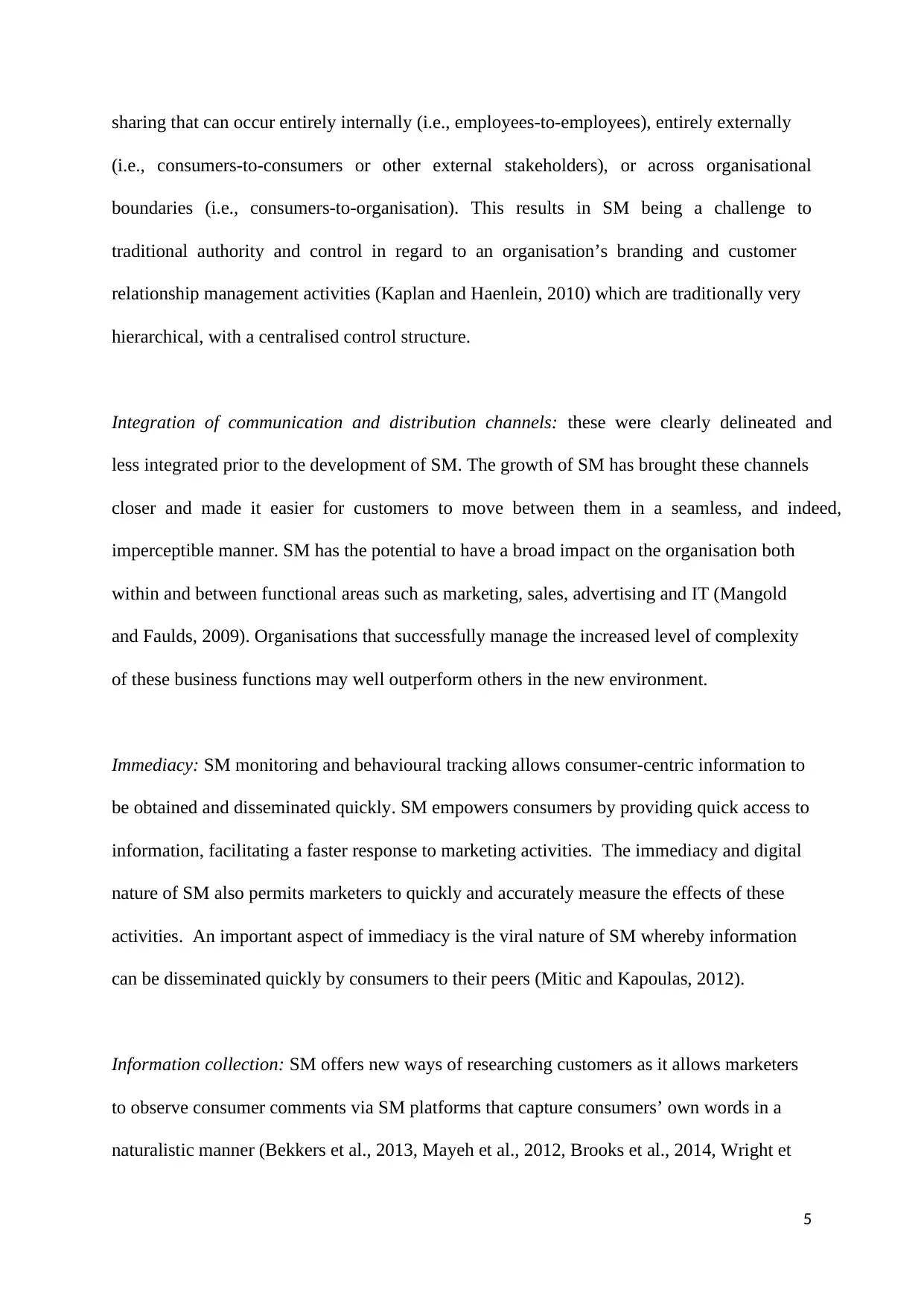
5
sharing that can occur entirely internally (i.e., employees-to-employees), entirely externally
(i.e., consumers-to-consumers or other external stakeholders), or across organisational
boundaries (i.e., consumers-to-organisation). This results in SM being a challenge to
traditional authority and control in regard to an organisation’s branding and customer
relationship management activities (Kaplan and Haenlein, 2010) which are traditionally very
hierarchical, with a centralised control structure.
Integration of communication and distribution channels: these were clearly delineated and
less integrated prior to the development of SM. The growth of SM has brought these channels
closer and made it easier for customers to move between them in a seamless, and indeed,
imperceptible manner. SM has the potential to have a broad impact on the organisation both
within and between functional areas such as marketing, sales, advertising and IT (Mangold
and Faulds, 2009). Organisations that successfully manage the increased level of complexity
of these business functions may well outperform others in the new environment.
Immediacy: SM monitoring and behavioural tracking allows consumer-centric information to
be obtained and disseminated quickly. SM empowers consumers by providing quick access to
information, facilitating a faster response to marketing activities. The immediacy and digital
nature of SM also permits marketers to quickly and accurately measure the effects of these
activities. An important aspect of immediacy is the viral nature of SM whereby information
can be disseminated quickly by consumers to their peers (Mitic and Kapoulas, 2012).
Information collection: SM offers new ways of researching customers as it allows marketers
to observe consumer comments via SM platforms that capture consumers’ own words in a
naturalistic manner (Bekkers et al., 2013, Mayeh et al., 2012, Brooks et al., 2014, Wright et
sharing that can occur entirely internally (i.e., employees-to-employees), entirely externally
(i.e., consumers-to-consumers or other external stakeholders), or across organisational
boundaries (i.e., consumers-to-organisation). This results in SM being a challenge to
traditional authority and control in regard to an organisation’s branding and customer
relationship management activities (Kaplan and Haenlein, 2010) which are traditionally very
hierarchical, with a centralised control structure.
Integration of communication and distribution channels: these were clearly delineated and
less integrated prior to the development of SM. The growth of SM has brought these channels
closer and made it easier for customers to move between them in a seamless, and indeed,
imperceptible manner. SM has the potential to have a broad impact on the organisation both
within and between functional areas such as marketing, sales, advertising and IT (Mangold
and Faulds, 2009). Organisations that successfully manage the increased level of complexity
of these business functions may well outperform others in the new environment.
Immediacy: SM monitoring and behavioural tracking allows consumer-centric information to
be obtained and disseminated quickly. SM empowers consumers by providing quick access to
information, facilitating a faster response to marketing activities. The immediacy and digital
nature of SM also permits marketers to quickly and accurately measure the effects of these
activities. An important aspect of immediacy is the viral nature of SM whereby information
can be disseminated quickly by consumers to their peers (Mitic and Kapoulas, 2012).
Information collection: SM offers new ways of researching customers as it allows marketers
to observe consumer comments via SM platforms that capture consumers’ own words in a
naturalistic manner (Bekkers et al., 2013, Mayeh et al., 2012, Brooks et al., 2014, Wright et
⊘ This is a preview!⊘
Do you want full access?
Subscribe today to unlock all pages.

Trusted by 1+ million students worldwide
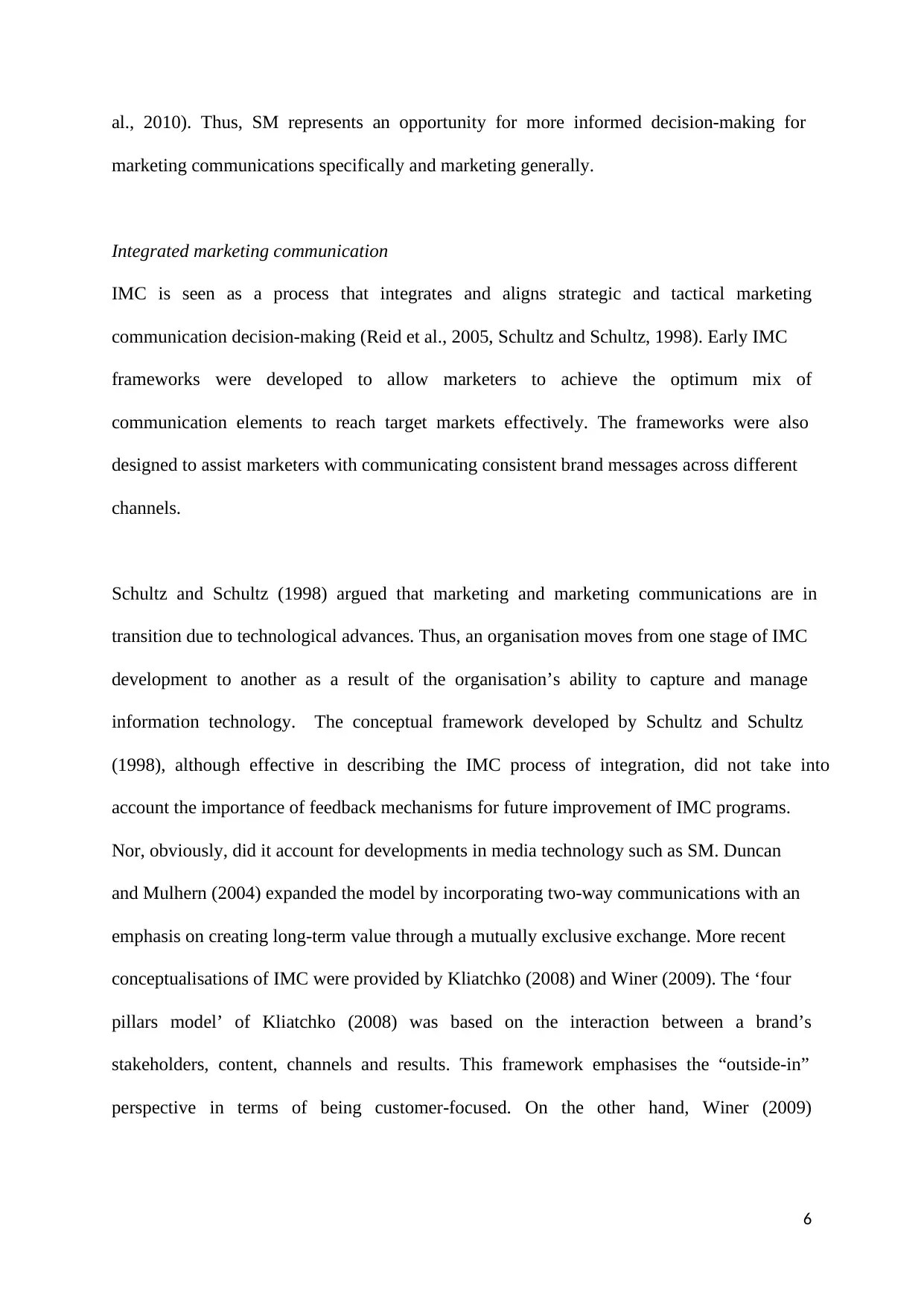
6
al., 2010). Thus, SM represents an opportunity for more informed decision-making for
marketing communications specifically and marketing generally.
Integrated marketing communication
IMC is seen as a process that integrates and aligns strategic and tactical marketing
communication decision-making (Reid et al., 2005, Schultz and Schultz, 1998). Early IMC
frameworks were developed to allow marketers to achieve the optimum mix of
communication elements to reach target markets effectively. The frameworks were also
designed to assist marketers with communicating consistent brand messages across different
channels.
Schultz and Schultz (1998) argued that marketing and marketing communications are in
transition due to technological advances. Thus, an organisation moves from one stage of IMC
development to another as a result of the organisation’s ability to capture and manage
information technology. The conceptual framework developed by Schultz and Schultz
(1998), although effective in describing the IMC process of integration, did not take into
account the importance of feedback mechanisms for future improvement of IMC programs.
Nor, obviously, did it account for developments in media technology such as SM. Duncan
and Mulhern (2004) expanded the model by incorporating two-way communications with an
emphasis on creating long-term value through a mutually exclusive exchange. More recent
conceptualisations of IMC were provided by Kliatchko (2008) and Winer (2009). The ‘four
pillars model’ of Kliatchko (2008) was based on the interaction between a brand’s
stakeholders, content, channels and results. This framework emphasises the “outside-in”
perspective in terms of being customer-focused. On the other hand, Winer (2009)
al., 2010). Thus, SM represents an opportunity for more informed decision-making for
marketing communications specifically and marketing generally.
Integrated marketing communication
IMC is seen as a process that integrates and aligns strategic and tactical marketing
communication decision-making (Reid et al., 2005, Schultz and Schultz, 1998). Early IMC
frameworks were developed to allow marketers to achieve the optimum mix of
communication elements to reach target markets effectively. The frameworks were also
designed to assist marketers with communicating consistent brand messages across different
channels.
Schultz and Schultz (1998) argued that marketing and marketing communications are in
transition due to technological advances. Thus, an organisation moves from one stage of IMC
development to another as a result of the organisation’s ability to capture and manage
information technology. The conceptual framework developed by Schultz and Schultz
(1998), although effective in describing the IMC process of integration, did not take into
account the importance of feedback mechanisms for future improvement of IMC programs.
Nor, obviously, did it account for developments in media technology such as SM. Duncan
and Mulhern (2004) expanded the model by incorporating two-way communications with an
emphasis on creating long-term value through a mutually exclusive exchange. More recent
conceptualisations of IMC were provided by Kliatchko (2008) and Winer (2009). The ‘four
pillars model’ of Kliatchko (2008) was based on the interaction between a brand’s
stakeholders, content, channels and results. This framework emphasises the “outside-in”
perspective in terms of being customer-focused. On the other hand, Winer (2009)
Paraphrase This Document
Need a fresh take? Get an instant paraphrase of this document with our AI Paraphraser
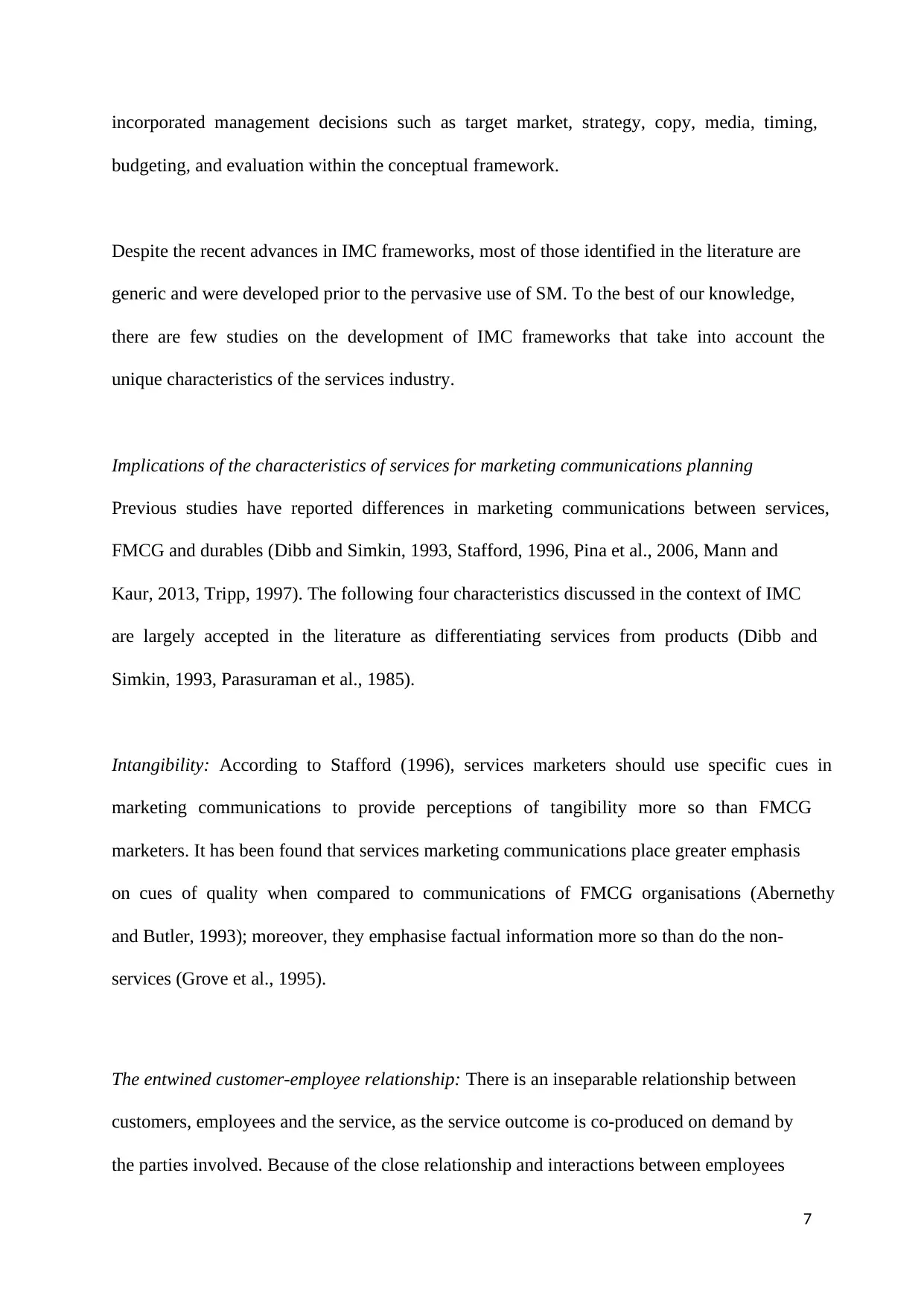
7
incorporated management decisions such as target market, strategy, copy, media, timing,
budgeting, and evaluation within the conceptual framework.
Despite the recent advances in IMC frameworks, most of those identified in the literature are
generic and were developed prior to the pervasive use of SM. To the best of our knowledge,
there are few studies on the development of IMC frameworks that take into account the
unique characteristics of the services industry.
Implications of the characteristics of services for marketing communications planning
Previous studies have reported differences in marketing communications between services,
FMCG and durables (Dibb and Simkin, 1993, Stafford, 1996, Pina et al., 2006, Mann and
Kaur, 2013, Tripp, 1997). The following four characteristics discussed in the context of IMC
are largely accepted in the literature as differentiating services from products (Dibb and
Simkin, 1993, Parasuraman et al., 1985).
Intangibility: According to Stafford (1996), services marketers should use specific cues in
marketing communications to provide perceptions of tangibility more so than FMCG
marketers. It has been found that services marketing communications place greater emphasis
on cues of quality when compared to communications of FMCG organisations (Abernethy
and Butler, 1993); moreover, they emphasise factual information more so than do the non-
services (Grove et al., 1995).
The entwined customer-employee relationship: There is an inseparable relationship between
customers, employees and the service, as the service outcome is co-produced on demand by
the parties involved. Because of the close relationship and interactions between employees
incorporated management decisions such as target market, strategy, copy, media, timing,
budgeting, and evaluation within the conceptual framework.
Despite the recent advances in IMC frameworks, most of those identified in the literature are
generic and were developed prior to the pervasive use of SM. To the best of our knowledge,
there are few studies on the development of IMC frameworks that take into account the
unique characteristics of the services industry.
Implications of the characteristics of services for marketing communications planning
Previous studies have reported differences in marketing communications between services,
FMCG and durables (Dibb and Simkin, 1993, Stafford, 1996, Pina et al., 2006, Mann and
Kaur, 2013, Tripp, 1997). The following four characteristics discussed in the context of IMC
are largely accepted in the literature as differentiating services from products (Dibb and
Simkin, 1993, Parasuraman et al., 1985).
Intangibility: According to Stafford (1996), services marketers should use specific cues in
marketing communications to provide perceptions of tangibility more so than FMCG
marketers. It has been found that services marketing communications place greater emphasis
on cues of quality when compared to communications of FMCG organisations (Abernethy
and Butler, 1993); moreover, they emphasise factual information more so than do the non-
services (Grove et al., 1995).
The entwined customer-employee relationship: There is an inseparable relationship between
customers, employees and the service, as the service outcome is co-produced on demand by
the parties involved. Because of the close relationship and interactions between employees
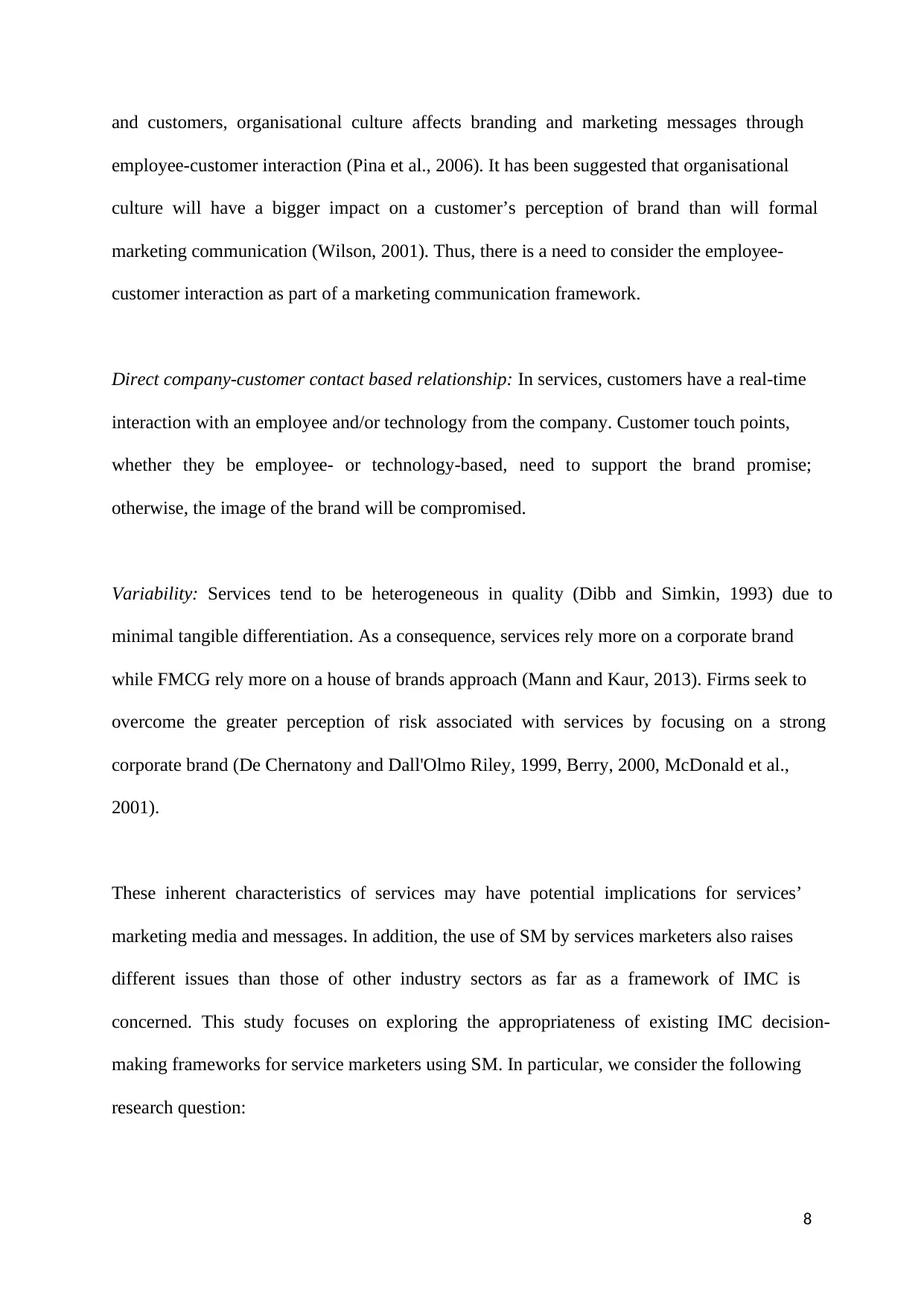
8
and customers, organisational culture affects branding and marketing messages through
employee-customer interaction (Pina et al., 2006). It has been suggested that organisational
culture will have a bigger impact on a customer’s perception of brand than will formal
marketing communication (Wilson, 2001). Thus, there is a need to consider the employee-
customer interaction as part of a marketing communication framework.
Direct company-customer contact based relationship: In services, customers have a real-time
interaction with an employee and/or technology from the company. Customer touch points,
whether they be employee- or technology-based, need to support the brand promise;
otherwise, the image of the brand will be compromised.
Variability: Services tend to be heterogeneous in quality (Dibb and Simkin, 1993) due to
minimal tangible differentiation. As a consequence, services rely more on a corporate brand
while FMCG rely more on a house of brands approach (Mann and Kaur, 2013). Firms seek to
overcome the greater perception of risk associated with services by focusing on a strong
corporate brand (De Chernatony and Dall'Olmo Riley, 1999, Berry, 2000, McDonald et al.,
2001).
These inherent characteristics of services may have potential implications for services’
marketing media and messages. In addition, the use of SM by services marketers also raises
different issues than those of other industry sectors as far as a framework of IMC is
concerned. This study focuses on exploring the appropriateness of existing IMC decision-
making frameworks for service marketers using SM. In particular, we consider the following
research question:
and customers, organisational culture affects branding and marketing messages through
employee-customer interaction (Pina et al., 2006). It has been suggested that organisational
culture will have a bigger impact on a customer’s perception of brand than will formal
marketing communication (Wilson, 2001). Thus, there is a need to consider the employee-
customer interaction as part of a marketing communication framework.
Direct company-customer contact based relationship: In services, customers have a real-time
interaction with an employee and/or technology from the company. Customer touch points,
whether they be employee- or technology-based, need to support the brand promise;
otherwise, the image of the brand will be compromised.
Variability: Services tend to be heterogeneous in quality (Dibb and Simkin, 1993) due to
minimal tangible differentiation. As a consequence, services rely more on a corporate brand
while FMCG rely more on a house of brands approach (Mann and Kaur, 2013). Firms seek to
overcome the greater perception of risk associated with services by focusing on a strong
corporate brand (De Chernatony and Dall'Olmo Riley, 1999, Berry, 2000, McDonald et al.,
2001).
These inherent characteristics of services may have potential implications for services’
marketing media and messages. In addition, the use of SM by services marketers also raises
different issues than those of other industry sectors as far as a framework of IMC is
concerned. This study focuses on exploring the appropriateness of existing IMC decision-
making frameworks for service marketers using SM. In particular, we consider the following
research question:
⊘ This is a preview!⊘
Do you want full access?
Subscribe today to unlock all pages.

Trusted by 1+ million students worldwide
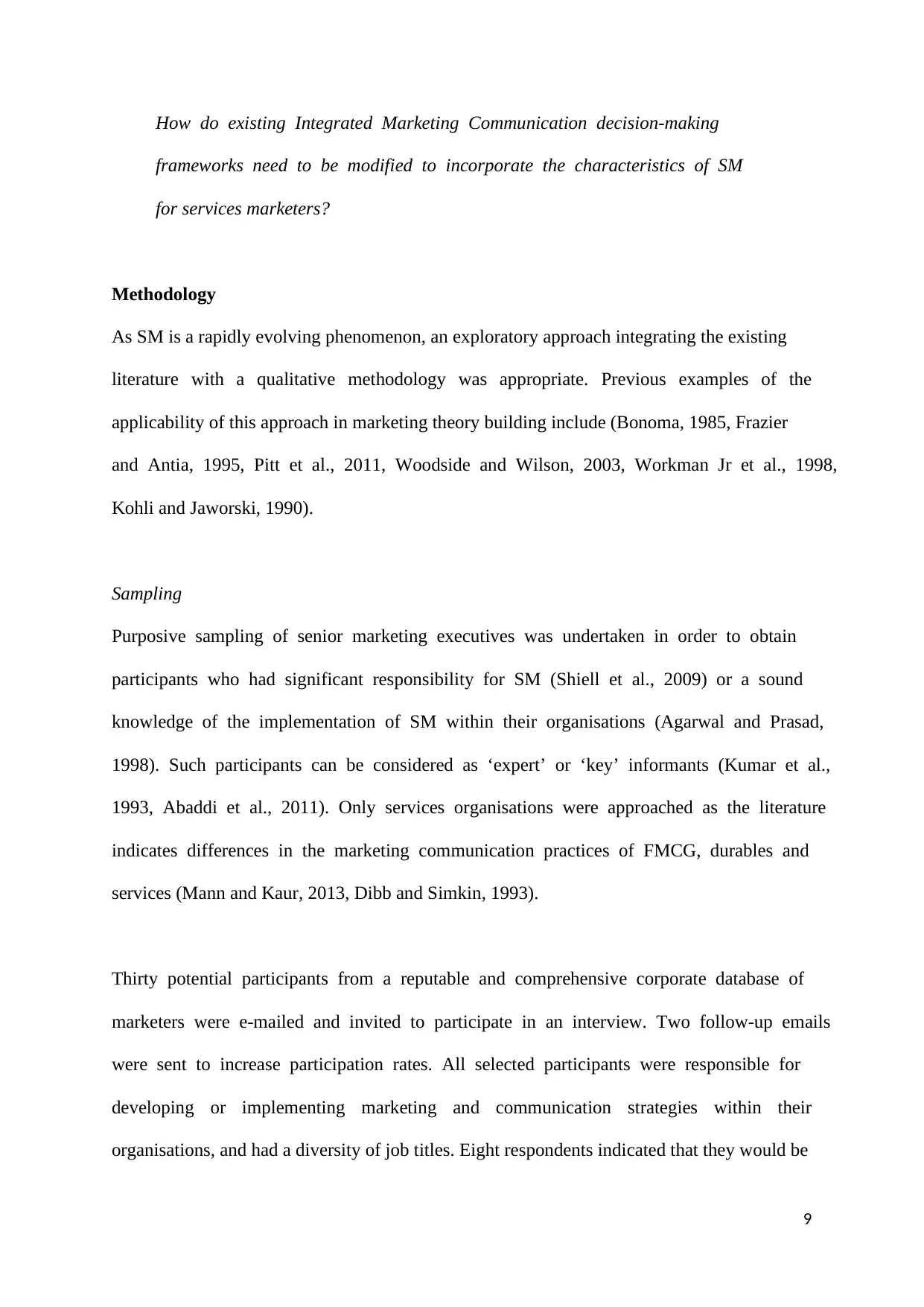
9
How do existing Integrated Marketing Communication decision-making
frameworks need to be modified to incorporate the characteristics of SM
for services marketers?
Methodology
As SM is a rapidly evolving phenomenon, an exploratory approach integrating the existing
literature with a qualitative methodology was appropriate. Previous examples of the
applicability of this approach in marketing theory building include (Bonoma, 1985, Frazier
and Antia, 1995, Pitt et al., 2011, Woodside and Wilson, 2003, Workman Jr et al., 1998,
Kohli and Jaworski, 1990).
Sampling
Purposive sampling of senior marketing executives was undertaken in order to obtain
participants who had significant responsibility for SM (Shiell et al., 2009) or a sound
knowledge of the implementation of SM within their organisations (Agarwal and Prasad,
1998). Such participants can be considered as ‘expert’ or ‘key’ informants (Kumar et al.,
1993, Abaddi et al., 2011). Only services organisations were approached as the literature
indicates differences in the marketing communication practices of FMCG, durables and
services (Mann and Kaur, 2013, Dibb and Simkin, 1993).
Thirty potential participants from a reputable and comprehensive corporate database of
marketers were e-mailed and invited to participate in an interview. Two follow-up emails
were sent to increase participation rates. All selected participants were responsible for
developing or implementing marketing and communication strategies within their
organisations, and had a diversity of job titles. Eight respondents indicated that they would be
How do existing Integrated Marketing Communication decision-making
frameworks need to be modified to incorporate the characteristics of SM
for services marketers?
Methodology
As SM is a rapidly evolving phenomenon, an exploratory approach integrating the existing
literature with a qualitative methodology was appropriate. Previous examples of the
applicability of this approach in marketing theory building include (Bonoma, 1985, Frazier
and Antia, 1995, Pitt et al., 2011, Woodside and Wilson, 2003, Workman Jr et al., 1998,
Kohli and Jaworski, 1990).
Sampling
Purposive sampling of senior marketing executives was undertaken in order to obtain
participants who had significant responsibility for SM (Shiell et al., 2009) or a sound
knowledge of the implementation of SM within their organisations (Agarwal and Prasad,
1998). Such participants can be considered as ‘expert’ or ‘key’ informants (Kumar et al.,
1993, Abaddi et al., 2011). Only services organisations were approached as the literature
indicates differences in the marketing communication practices of FMCG, durables and
services (Mann and Kaur, 2013, Dibb and Simkin, 1993).
Thirty potential participants from a reputable and comprehensive corporate database of
marketers were e-mailed and invited to participate in an interview. Two follow-up emails
were sent to increase participation rates. All selected participants were responsible for
developing or implementing marketing and communication strategies within their
organisations, and had a diversity of job titles. Eight respondents indicated that they would be
Paraphrase This Document
Need a fresh take? Get an instant paraphrase of this document with our AI Paraphraser
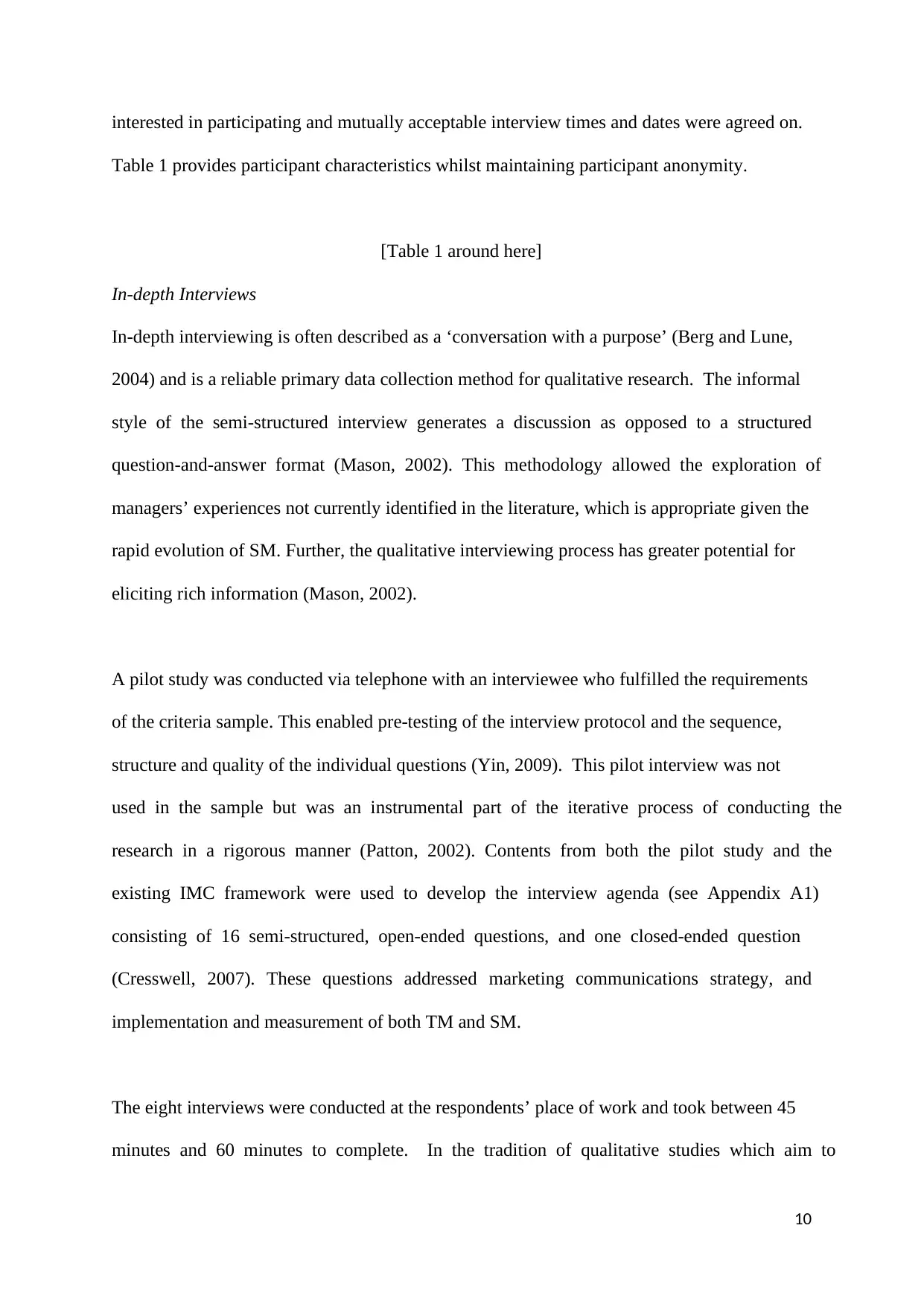
10
interested in participating and mutually acceptable interview times and dates were agreed on.
Table 1 provides participant characteristics whilst maintaining participant anonymity.
[Table 1 around here]
In-depth Interviews
In-depth interviewing is often described as a ‘conversation with a purpose’ (Berg and Lune,
2004) and is a reliable primary data collection method for qualitative research. The informal
style of the semi-structured interview generates a discussion as opposed to a structured
question-and-answer format (Mason, 2002). This methodology allowed the exploration of
managers’ experiences not currently identified in the literature, which is appropriate given the
rapid evolution of SM. Further, the qualitative interviewing process has greater potential for
eliciting rich information (Mason, 2002).
A pilot study was conducted via telephone with an interviewee who fulfilled the requirements
of the criteria sample. This enabled pre-testing of the interview protocol and the sequence,
structure and quality of the individual questions (Yin, 2009). This pilot interview was not
used in the sample but was an instrumental part of the iterative process of conducting the
research in a rigorous manner (Patton, 2002). Contents from both the pilot study and the
existing IMC framework were used to develop the interview agenda (see Appendix A1)
consisting of 16 semi-structured, open-ended questions, and one closed-ended question
(Cresswell, 2007). These questions addressed marketing communications strategy, and
implementation and measurement of both TM and SM.
The eight interviews were conducted at the respondents’ place of work and took between 45
minutes and 60 minutes to complete. In the tradition of qualitative studies which aim to
interested in participating and mutually acceptable interview times and dates were agreed on.
Table 1 provides participant characteristics whilst maintaining participant anonymity.
[Table 1 around here]
In-depth Interviews
In-depth interviewing is often described as a ‘conversation with a purpose’ (Berg and Lune,
2004) and is a reliable primary data collection method for qualitative research. The informal
style of the semi-structured interview generates a discussion as opposed to a structured
question-and-answer format (Mason, 2002). This methodology allowed the exploration of
managers’ experiences not currently identified in the literature, which is appropriate given the
rapid evolution of SM. Further, the qualitative interviewing process has greater potential for
eliciting rich information (Mason, 2002).
A pilot study was conducted via telephone with an interviewee who fulfilled the requirements
of the criteria sample. This enabled pre-testing of the interview protocol and the sequence,
structure and quality of the individual questions (Yin, 2009). This pilot interview was not
used in the sample but was an instrumental part of the iterative process of conducting the
research in a rigorous manner (Patton, 2002). Contents from both the pilot study and the
existing IMC framework were used to develop the interview agenda (see Appendix A1)
consisting of 16 semi-structured, open-ended questions, and one closed-ended question
(Cresswell, 2007). These questions addressed marketing communications strategy, and
implementation and measurement of both TM and SM.
The eight interviews were conducted at the respondents’ place of work and took between 45
minutes and 60 minutes to complete. In the tradition of qualitative studies which aim to
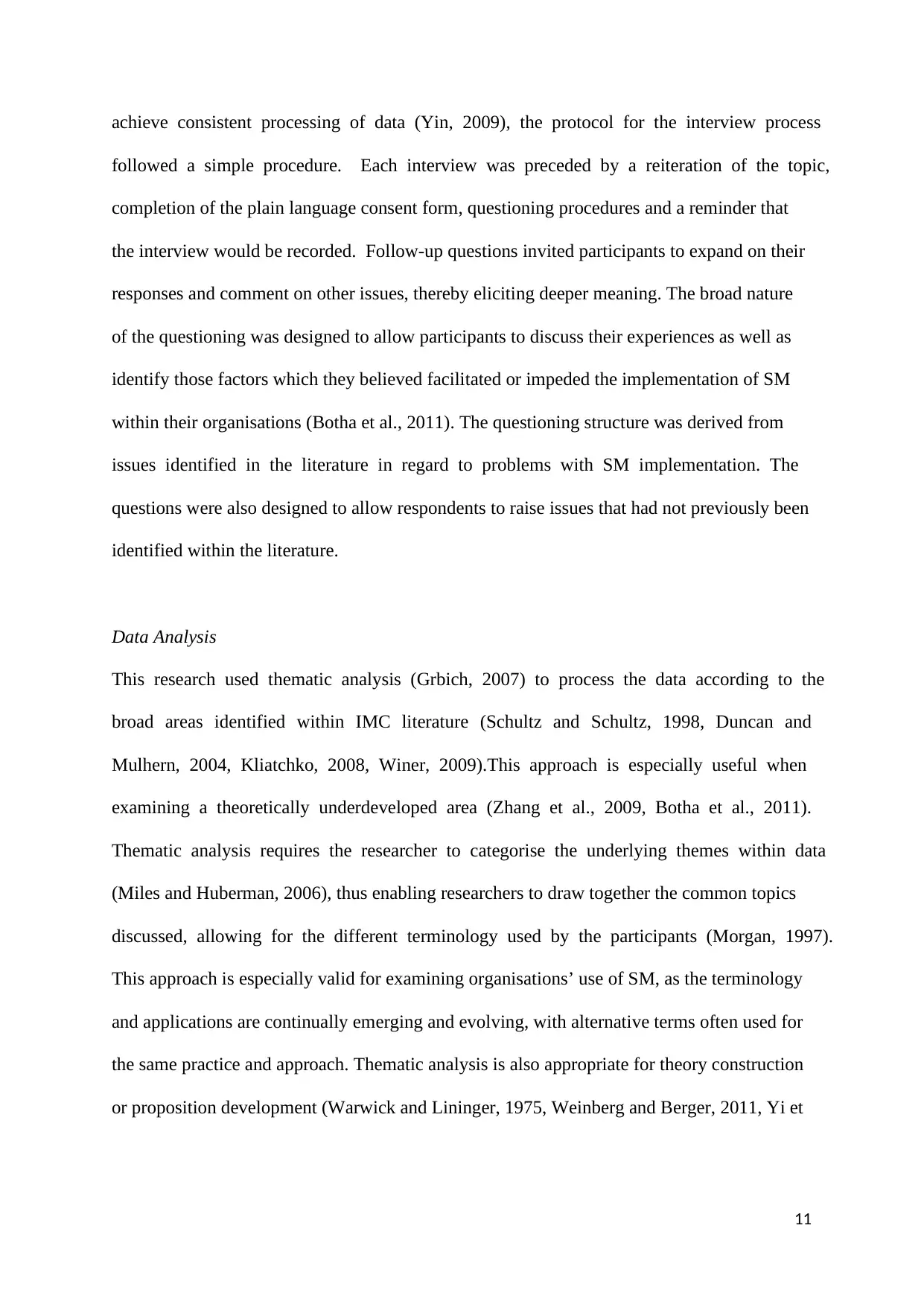
11
achieve consistent processing of data (Yin, 2009), the protocol for the interview process
followed a simple procedure. Each interview was preceded by a reiteration of the topic,
completion of the plain language consent form, questioning procedures and a reminder that
the interview would be recorded. Follow-up questions invited participants to expand on their
responses and comment on other issues, thereby eliciting deeper meaning. The broad nature
of the questioning was designed to allow participants to discuss their experiences as well as
identify those factors which they believed facilitated or impeded the implementation of SM
within their organisations (Botha et al., 2011). The questioning structure was derived from
issues identified in the literature in regard to problems with SM implementation. The
questions were also designed to allow respondents to raise issues that had not previously been
identified within the literature.
Data Analysis
This research used thematic analysis (Grbich, 2007) to process the data according to the
broad areas identified within IMC literature (Schultz and Schultz, 1998, Duncan and
Mulhern, 2004, Kliatchko, 2008, Winer, 2009).This approach is especially useful when
examining a theoretically underdeveloped area (Zhang et al., 2009, Botha et al., 2011).
Thematic analysis requires the researcher to categorise the underlying themes within data
(Miles and Huberman, 2006), thus enabling researchers to draw together the common topics
discussed, allowing for the different terminology used by the participants (Morgan, 1997).
This approach is especially valid for examining organisations’ use of SM, as the terminology
and applications are continually emerging and evolving, with alternative terms often used for
the same practice and approach. Thematic analysis is also appropriate for theory construction
or proposition development (Warwick and Lininger, 1975, Weinberg and Berger, 2011, Yi et
achieve consistent processing of data (Yin, 2009), the protocol for the interview process
followed a simple procedure. Each interview was preceded by a reiteration of the topic,
completion of the plain language consent form, questioning procedures and a reminder that
the interview would be recorded. Follow-up questions invited participants to expand on their
responses and comment on other issues, thereby eliciting deeper meaning. The broad nature
of the questioning was designed to allow participants to discuss their experiences as well as
identify those factors which they believed facilitated or impeded the implementation of SM
within their organisations (Botha et al., 2011). The questioning structure was derived from
issues identified in the literature in regard to problems with SM implementation. The
questions were also designed to allow respondents to raise issues that had not previously been
identified within the literature.
Data Analysis
This research used thematic analysis (Grbich, 2007) to process the data according to the
broad areas identified within IMC literature (Schultz and Schultz, 1998, Duncan and
Mulhern, 2004, Kliatchko, 2008, Winer, 2009).This approach is especially useful when
examining a theoretically underdeveloped area (Zhang et al., 2009, Botha et al., 2011).
Thematic analysis requires the researcher to categorise the underlying themes within data
(Miles and Huberman, 2006), thus enabling researchers to draw together the common topics
discussed, allowing for the different terminology used by the participants (Morgan, 1997).
This approach is especially valid for examining organisations’ use of SM, as the terminology
and applications are continually emerging and evolving, with alternative terms often used for
the same practice and approach. Thematic analysis is also appropriate for theory construction
or proposition development (Warwick and Lininger, 1975, Weinberg and Berger, 2011, Yi et
⊘ This is a preview!⊘
Do you want full access?
Subscribe today to unlock all pages.

Trusted by 1+ million students worldwide
1 out of 34
Related Documents
Your All-in-One AI-Powered Toolkit for Academic Success.
+13062052269
info@desklib.com
Available 24*7 on WhatsApp / Email
![[object Object]](/_next/static/media/star-bottom.7253800d.svg)
Unlock your academic potential
Copyright © 2020–2025 A2Z Services. All Rights Reserved. Developed and managed by ZUCOL.





